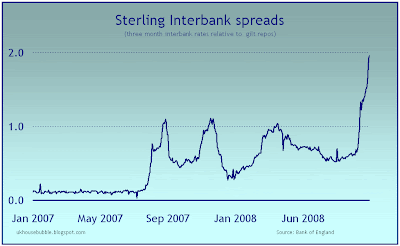 The credit crunch is now almost 14 months old, and the disruption in financial markets is reaching unprecedented levels. The interbank market has all but collapsed. So just how bad have things become? Why have things reached this desperate situation?
The credit crunch is now almost 14 months old, and the disruption in financial markets is reaching unprecedented levels. The interbank market has all but collapsed. So just how bad have things become? Why have things reached this desperate situation?The chart above tracks the spread (i.e. difference) between the interest rate on 3 month interbank loans and the rate on gilt repos. For those unfamiliar with the term "gilt repo". It is a loan between two parties where the borrower offers collateral in the form of a gilt, which is a UK government treasury bill. It is therefore a riskless loan because in the event of default, the lender keeps the gild. An interbank loan is unsecured and therefore much more risky.
With the explanation over, lets look at what has happened to the spread in the last 20 or so months. Before the credit crunch, the spread was just 0.12 basis points, or 12 basis points. Yesterday, the spread was 1.96 percent or 196 basis points - an unprecedented level. In fact, this week's Bank of England interest rate reduction had absolutely no effect on interbank interest rates.
Why has the spread remained so high after the most extraordinary attempts by the Bank of England and the governmetn to bring it down and return the interbank market to normality. There are three explanations.
The risk premium is now permanently higher
The Bank of England don't like to hear this, but interbank spreads may be permanently higher due to the increased risk of lending within the banking system. Out of the top 10 mortgage lenders in this country, two have failed and a further two were taken over. Other banks have seen their share price collapse as investors have become increasingly aware of a lack of bank capital.
Therefore, it should surprise no one that the risk premium, i.e. the spread, should rise accordingly. Moreover, attempts to bring it down are bound to fail. Therefore, the banks, the BoE and the government just have to live with the new high risk reality.
More banks may fail
The higher spread could also represent a perception that more banks are likely to run into trouble in the future, and despite the best efforts of the authorities, the risk of loss remains. Therefore, it would be unwise for any bank holding a large amounts of cash to lend these funds, especially over a long maturity like a year.
This explanation differs from the first because it touches on the credibility of the government itself. It may find it difficult to find the resources to bail out banks who run into trouble in the future. Whatever Darling and Brown may think, the government can not count on infinite amounts of taxpayers resources to fix the banks.
Bank bailouts are very expensive. The Northern rock nationalisation added about 7 percent of GDP to the government debt stock. Bradford & Bingley wasn't quite such a ghastly failure, but it too added billions of pounds of liabilities that the government are now having to clean up.
Central bank credit operations may be undermining the market
Central banks within Europe and North America have now become not only the lender of last resort, but the only lender. Central banks slipped into this difficult position by offering increasing amounts of credit at below market interest rates. The interbank market simply cannot compete with this massive injection of subsidised credit. Moreover, any bank tried to access the regular market would stand out, raising questions why it wasn't going to the central bank in the first place.
Pump, pump, pump
Whatever the reasons behind the unprecedented increase in spreads, central banks are working desperately to bring the spread down. They are pumping out unprecedented amounts of liquidity. Many countries have begun to guarantee deposits. A worldwide move to nationalise banks is well underway, with the UK in the lead.
Make no mistake, it is a desperate situation.
4 comments:
Desperate? Terminal more like.
The problem has all along been one of insolvency rather than lack of liquidity; it is exacerbated by collapsing confidence, not created by it.
Banks A knows its own balance sheet is shot; it therefore naturally suspects Bank B is insolvent too, and vice versa. Neither lends to the other.
All banks limp along deliberately insisting on a big interbank spread as a way of rebuilding balance sheets. Central banks supply liquidity at artificially low rates in a taxpayer funded assist in this attempted rejuvenation.
In the UK Brown and Darling in practice guarantee every retail deposit. Were they not to do this, there would be an instant run on all the banks, and the show would be over.
Yes, nationalisation is the only option. But what a pity that the UK government may actually pay to take over bust institutions! Who pays to become responsible for another's debts? The saintly British taxpayer, it seems!
I hope the government does not hinder the necessary job losses in the vastly bloated banking sector.
Perhaps the government will also have the courage to reduce bankers' pay. After all, there is now rather reduced demand for these 'brightest and best.'
B. in C.
It's hardly surprising banks are reluctant to lend. In addition to the increased risk, there's also the fact that with even the fudged CPI showing 4.7%, banks will 'officially' lose money if they lend at rates close to bank base.
Maybe the market IS working after all? Banks are merely unwilling to lend at the official rate because the official rate is too low!
Post a Comment